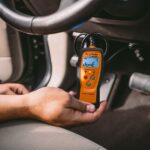It’s a common scenario: your car is acting up, and the first thing your mechanic does is plug in a diagnostic tool. We often put a lot of faith in these digital readouts, expecting them to pinpoint the problem immediately. But is it possible that a car diagnostic can be wrong? While incredibly helpful, it’s important to understand that car diagnostics are not infallible and sometimes require further investigation to get to the real root of the issue.
The Power of Car Diagnostics – What They Usually Get Right
Modern car diagnostic systems are sophisticated. They tap into your car’s onboard computer, reading trouble codes and sensor data that can quickly highlight potential problems. These systems, particularly OBD-II (On-Board Diagnostics II), are designed to monitor various aspects of your vehicle’s performance, from engine and transmission to emissions and braking systems. When a sensor detects an issue outside of normal parameters, it triggers a trouble code, which a diagnostic tool can then read.
This technology is invaluable for mechanics. It provides a starting point, often significantly narrowing down the area of the car that needs attention. For many common issues, the diagnostic scan is accurate and leads directly to the correct repair. It helps identify problems that might be difficult to detect through visual inspection alone, saving time and effort in the repair process.
When Car Diagnostics Miss the Mark – Understanding Potential Errors
However, relying solely on the initial diagnostic scan can sometimes be misleading. While a diagnostic test is a great tool, it’s not a magic bullet. There are several reasons why a car diagnostic can be wrong, or at least, not completely accurate on its own:
- OBD-II Codes Are General Indicators: Trouble codes like P0128 (mentioned in the original article, indicating an issue with engine coolant temperature) are not specific instructions. They signal a system or component area where a problem exists, but not necessarily the exact failed part. In the P0128 example, the code could be triggered by low coolant, a faulty thermostat, or even a malfunctioning temperature sensor. The diagnostic code points to a problem within the cooling system but doesn’t specify the precise cause.
- Multiple Faults and Interconnected Systems: Cars are complex systems where problems can be interconnected. One issue might trigger codes that seem unrelated or mask other underlying problems. Fixing the initially indicated issue might not resolve the original symptom if another problem is also present. Mechanics sometimes need to address issues in layers, as resolving one problem can reveal another that was previously masked.
- Sensor Malfunctions: Ironically, the very sensors that provide diagnostic data can sometimes fail. A faulty sensor might provide incorrect readings, leading to inaccurate trouble codes and misdiagnosis. For example, a failing oxygen sensor could trigger codes suggesting catalytic converter issues when the sensor itself is the culprit.
- Human Error in Interpretation: Diagnostic tools provide data, but it’s the mechanic’s expertise that interprets this data. Misinterpreting the codes, overlooking related symptoms, or making assumptions based solely on the scan can lead to incorrect diagnoses and unnecessary repairs. Even experienced technicians can sometimes make mistakes, especially with complex or unusual problems.
The Importance of Expertise – Why Skilled Mechanics Matter
This is where the skill and experience of a qualified mechanic become crucial. A good mechanic uses the diagnostic scan as a starting point, not the definitive answer. They will:
- Perform Further Tests: Based on the diagnostic codes and the car’s symptoms, a skilled technician will conduct further tests to pinpoint the exact cause of the problem. This might involve visual inspections, manual tests (like pressure testing or electrical circuit checks), and using specialized tools like oscilloscopes to analyze electrical signals.
- Consider the Context: Experienced mechanics consider the vehicle’s history, driving conditions, and the owner’s description of the problem alongside the diagnostic data. This holistic approach helps in making a more accurate diagnosis.
- Use Diagnostic Tools as Guides: They understand the limitations of diagnostic tools and use them as guides in a broader diagnostic process, not as definitive oracles.
Conclusion
So, can a car diagnostic be wrong? Yes, in the sense that it’s not always a complete and final answer. Car diagnostic tests are incredibly valuable tools that significantly aid in identifying car problems. However, they are just one part of the diagnostic process. Accurate car repair relies on a combination of technology and human expertise. A skilled mechanic will use diagnostic information wisely, conduct thorough investigations, and consider all factors to ensure your car is diagnosed correctly and repaired effectively. The key is to see a diagnostic scan as the beginning of the problem-solving process, not the end.

